Abtract
In this article, a tool called "transsentientist critical path methodology" will be presented as an addition to the current toolbox of the scientific field of Effective Altruism. Its applicability is here demonstrated on the focus areas of 1) the global scientific research community, and 2) the United Nation’s Sustainable Development Goals. The tool introduces a metric system of “Sentions” to assign weight to large altruistic actions. The applicability shows promise as a new standard for gamification of non-utilitarian effective altruism because of its ability to readily produce a dashboard presenting a ranking of altruistic projects worldwide than the current tools have offered. This could, in turn, increase both the precision and the attractiveness of EA as a scientific field.
Keywords: Effective altruism, rule utilitarianism, bright sentience, critical path methodology, Sentions, transsentientism, ranking, preservation.
1. Introduction
The only thing one can take with oneself to the grave is perhaps that which s/he has given away. The gifts to others during a lifetime are constrained by one’s investment of time, money, and political engagement. This vantage point gives weight to the strategic philosophy of utilitarianism, the softer rule utilitarianism, and the yet softer effective altruism (EA).
EA differs from utilitarianism in several ways, two of them being that 1) EA in contrast to utilitarianism does not claim whether it’s obligatory or merely supererogatory to spend one’s resources helping others; and 2) EA does not claim that there are no other things besides welfare that are of value; utilitarianism does claim this (MacAskill 2019). In EA, some effort is placed on the philosophical comparative analysis of the greater good for the far future. This paper is centred around EA rather than rule utilitarianism.
The purpose of this paper is to demonstrate the applicability of a new tool that can be called Transsentientist Critical Path (TCP) methodology. In this demonstration, the various input parameters for the tool will be collected and analysed. The results will then be compared to the current results from the EA community, and based on an overlay analysis, the uniqueness of the tool with be discussed and concluded.
The TCP methodology is following two of the three basic principles in EA, namely estimates of both the magnitude and neglectedness of problems through empirical data in the form of a proposed expert survey, which would take place in the fall of 2020. The third principle in EA, solvability, is not addressed in this paper. This is because the TCP methodology focuses on a technological maturity level that is so much larger than our current maturity level that the solvability becomes distorted.
The emergence of the scientific field of EA comes at an opportune time in history. With the advancement of technological research comes the opportunity to improve our society in a plethora of ways. Technologies and inventions are branches and fruits on the global technology tree. The canopy of our technology tree is widening fast, and with it - the complexity and interrelations of visions for the use of technologies. With this widening comes a necessity to unite and connect visions in order to build a strong foundation for altruism in the society and remind ourselves of the purpose of collaborating and building a better future together. This is arguably the fastest route to combating illnesses, pain, instability, and paralysis. In other words, a condensation of the science input, processing, and output of EA is needed to unite and gamify.
This paper examines to what extend the TCP methodology overcomes this challenge. Using transsentientism, this paper examines the applicability of a new metric system of a suggested unit called Sentions to assign value to altruistic actions. A common unit used currently in EA is the Quality-Adjusted Life-Year (QALY) which often relates to health. The Sention on the other hand is a unit of the amount of sentiense in a conscious entity and refers to the amount of neural communication that creates the sentience. The findings from the proposed transsentientism-based EA focus areas will be weighed against two currently prevailing paradigms, namely 1) the existing focus areas of the global scientific research sector, and 2) the United Nation’s Sustainable Development Goals (SDGs). These two comparisons are an attempt to address the current landscape of time, money, and political engagement invested in various altruistic acts.
If transsentientism and the Sention metric system proves valuable to the scientific field of EA, e.g. by providing a platform for scientific condensation, visualisation, and gamification, then EA could become more attractive to potential future investors.
2. Theory
In weighing two altruistic acts against each other to find the most altruistic one of them, one must move away from mental biases and discriminations, and at the same time move towards the most effective options. One must therefore 1) not exclude, (eliminate all discrimination), and 2) include, (find the most effective meaningful and genuinely good and kind action). These two rules are the foundation of the TCP methodology, and are unfolded respectively below.
Why use a transsentientist critical path methodology?
Two dimensions of effectively altruistic actions are the movement of as large a field as possible at the fastest movement possible. While transsentientism is a desire to source altruism from the largest possible field, critical path methodology is a tool to estimate the fastest possible movement. The TCP methodology therefore makes for a powerful match in the search for the most effective altruism.
Transsentientism and deprovinsialisation
When homo sapiens were hunters and gatherers 100.000 years ago, we lived in an assumingly flat earth where the stars and the sun all rose in the east and set in the west. We used the stars to entertain, narrate, navigate and mythologize. The flat ground beneath us seemingly stood still. This seemed an observed fact and anyone who didn’t agree with that must have seemed crazy. It therefore must have felt natural to assume that the Earth was the centre of the universe. This is the geocentric conceit. The centre of the universe surely must be important place. Moreover, what other animal made use of the planets and the stars? It was only us humans. Therefore, it seemed obvious that the stars must have been put there for our benefit. And the sun and the moon were practical objects. The centrality of our position was stunning. To the alien observer, this prevalence of the geo-centric conceit could classify Earth as the ‘Planet of the idiots’. But according to Sagan (1994), this judgement is too harsh. He explains:
“There is a resonance here between what is verifiably observed and our emotional hopes and needs. The idea that the universe has been made for us – not because of any particular merit, but just because we are here, or just because we are human, is a weakness of ours that resonates with the same psychic wellsprings responsible for the view that our nation, gender, ethnic group etc. is special and the centre of the Universe. We have a weakness and scientists are creatures of the culture in which they swim, in which they have grown up, and so we also are vulnerable to this siren song which we can call chauvinism or geo-centrism, or anthropo-centrism… …We went on – every human culture – every great philosopher – every scientist – every religious leader – thinking that we were at the centre of the Universe. We put it in various guises in our scriptures, declared the scriptures to be infallible – thereby making it not just a secular, but a religious crime to even think about the issue” – Sagan (1994)
The geo- and anthropocentric deceit was challenged various times in various locations during the enlightenment. One of the more noteworthy of those times was in 1543 when Polish astronomer Nicolas Copernicus on his deathbed published his earlier written book “On the revolutions of the celestial spheres” in which he challenged the belief that Earth (and thus humans) were at the centre of the Universe. The book had a preface by a well-meaning friend of his – Alexander – which attempted to buffer the reader’s inevitable digression into his or her cultural preconception that it was a crime to question the Earth’s centrality.
In 1610, the Italian Galileo published his defence of Copernicus called “Starry messenger”. 23 years later, he was sentenced to indefinite imprisonment due to heresy. But the stage had been set and in1728James Bradley discovered the aberration of light. When Friedrich Bessel in 1838 conducted the first successful measurements of stellar parallax,the opposition collapsed, and now we are all taught that the Earth is not at the centre of the Universe. Nevertheless, the daunting and disquieting discovery that the Earth is not at the centre remains a futile truth in many minds today. The seeming futility of this truth is a profound driver of the provincialisation of altruism and one that the here proposed term, transsentientism, attempts to overcome.
Like geo-centrism, anthropocentrism also lives on and is still prevalent today. The notions prevailed, that no one else than humans has altruism, compassion, love for their young, ability to foresee consequences of present actions, ability to enjoy art, music, or ability to use and make tools. This was essentially agreed to by Plato, Aristotle, Saint Agustine, Saint Thomas Aquinas, Hobbs, and Locke – except David Hume – hats off to him – and all other scientists – including the sceptical ones, and all religious leaders until, in 1859, Charles Darwin initiated the collapse of anthropocentrism by showing that abes are our cousins – to a similar fashion that Copernicus had initiated the collapse of geo-centrism in 1543.
With the industrialisation came, however other discourses which yet again gave support for anthopo-centrism; both the mechanistic model of the Universe founded by Descartes, and the underlying current of speciesism, first used by Ryder (1970). The mechanistic and phenomenal consciousness model states that a significant amount of cerebral activity and organisation is needed in order to create consciousness. If correct, a more anthropocentric world model is justified, but if not, it is yet another provincialized anthropocentric deceit which fuses our hopes and needs of relative importance.
On the far other side of the spectrum is pan-psychism which supports the electrical universe model in which it is argued that stars, galaxies and the greater cosmos itself is sentient through electromagnetic and luminal communication – creating a cosmic mind.
The jury is still out on which model is the truer of the above. However, this paper argues for the term transsentientism because of the moral obligation to act in accordance with the precautionary principle and thus assume that the less provincial model is the truest.
The growing sentience economy
Sentience is arguably quantitative and qualitative. In the first 0.4 billion years after the big bang, the Universe contained only gasses, and was perhaps without any life. It was a giant cosmic stage with no audience. Then, the first stars started to form; and later, planets. Perhaps, life had still not begun. Stars being born and dying for aeons. All that marvellous light for nothing. All the sunsets over sandy shores. All the night skies and towering snow-covered mountain ranges. All the deep oceans, lush waterfalls, spectacular moons, colourful rainbows, and shooting stars. Or to borrow Sagan’s often used phrase, all the lonely specks of planets in the great enveloping cosmic dock. All for nothing. If there was no life, there was no love to be found anywhere. No hope. No gratitude. No marvel or awe. No fun. No humour. No peace. No purpose. No freedom. No suffering, struggle, or melancholy. No learning. There was nothing to give anything any value or meaning.
Then, the Universe found a way to observe itself. First, through organisms with little sense of the world around them, and later through organisms with various senses. While some sensed heat, others sensed tactile touch, immature sight, or magnetism. If the sentience of the Universe before life was like a black closed uniform ball, it was now a black ball with microscopic holes of dim light shining through the otherwise infinitely dark ball of sentience. These dimly shining holes were the first glimpse of sentience and thus a first meaning with everything and anything. They were the first (known) life to assign value to something. With time, as the senses and experiences got a bit deeper in the small organisms by developing taste and smell, the universe got better and better at observing itself. The microscopic dim light shining through these new holes in the black cosmic ball got a bit brighter.
Sentience is according to the Oxford Dictionary the capacity for perception or feeling. It is, as argued above, not a binary terminology but rather a quantitative and qualitative variable that increases in size when the communication between sensory cells in an organism increases. To ease the terminologies ‘quantitative’ and ‘qualitative’, this paper proposes that any sentience can brighten if feelings or sensations are interpreted by the experiencer as being more pleasant and happiness-inducing and can, similarly, darken if they are interpreted by the experiencer as more unpleasant or happiness-reducing. Similarly, sentience can expand if communication is added and shrink if communication is reduced.
Figure 1 illustrates a feeling wheel in which prevalent human feelings are listed. For the sake of simplicity, this article assumes that the spectrum of feelings be split in two equally large parts where the one side is brighter and the other is darker.

Figure 2 introduces a depth to this feeling wheel defined by the amount of sensory communication of a mind. Here, sentience can be seen as a substance with a volume equal to the volume of any given cylinder, containing brighter and darker parts of the substance.

If all sentience is confined to being matter and energy and not dark matter or dark energy, then the sentience on Earth can be reduced to reside within in the 5.972 × 10^24 kg matter that makes up the mass of the Earth. This potential real estate of sentience can be illustrated as a disc where the total surface area equals this mass. Such a disc would have a radius of around 3000 Mt. Figure 3 illustrates such a disc before life began on it.
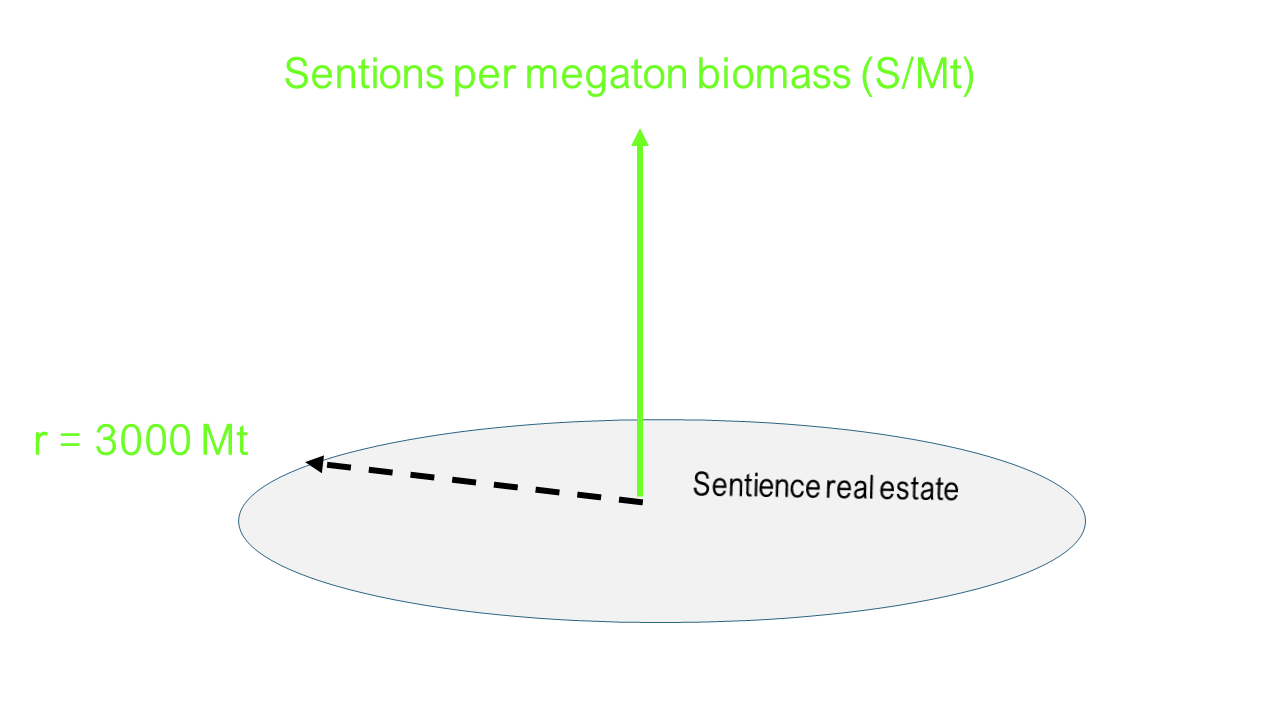
Following this line of thought, and for the sake of understanding, a hypothetical future scenario could be imagined in which the intensity of the sentient mass on Earth is extremely high, creating a very deep sentience. Figure 4 is an example of such extreme scenario and is illustrated with a tree of sentience.
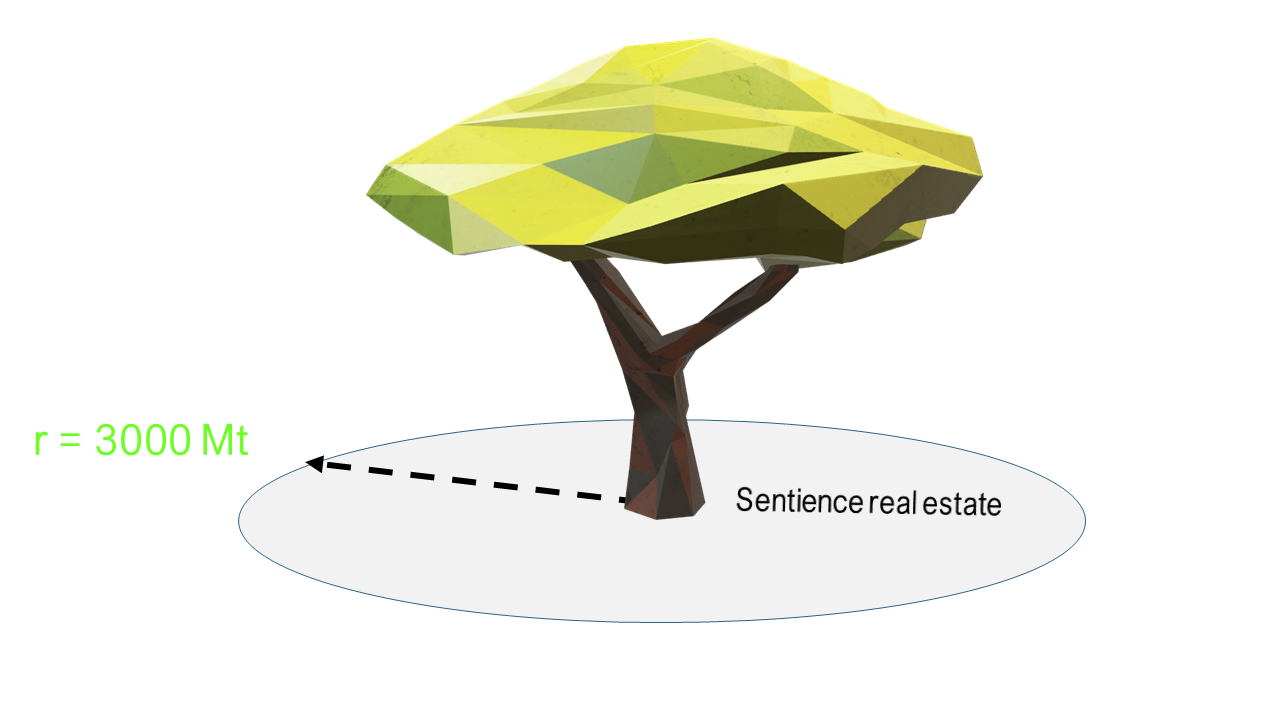
In another hypothetical scenario where this disc surface was to be completely covered by cylinders, then that would mean that every single molecule would have become sentient to some degree. If the entire disc were covered by a deep cylinder, that would mean that the whole Earth had become very sentient.
In Figure 5 below, the current topography of sentience on our 3000 Mt radius Earth is illustrated. Here only a tiny fraction (about a tenth of a billionth of the surface is covered by cylinders (note the logarithmic dimensions). It has a radius of 7 Mt, which corresponds to the current biomass on Earth. Five cylinders (or spheres of being) are depicted representing non-brain sentience, reptiles, mammals, humans, and AIs. There is a shadow side on all five cylinders which represent a darker sentience than the “sunnier” sides of the cylinders which represent a brighter sentience. Neither total black nor total white is depicted here because it is assumed that neither total happiness nor total unhappiness are a part of the current sentience experience on Earth currently. The vertical axis is logarithmic, meaning that the depth of any cylinder is proportionally much larger than any shallower cylinder.
The substance of the five cylinders have various levels of transparency. This serves to illustrate the current scientific understanding of the probability of sentience. In this way, following the transparency levels, non-brain sentience, reptiles, and AI have a relatively low level of probability of sentience compared to mammals and humans. Mammals and humans have similarly a lower level of probability of sentience compared to your own current sentience.
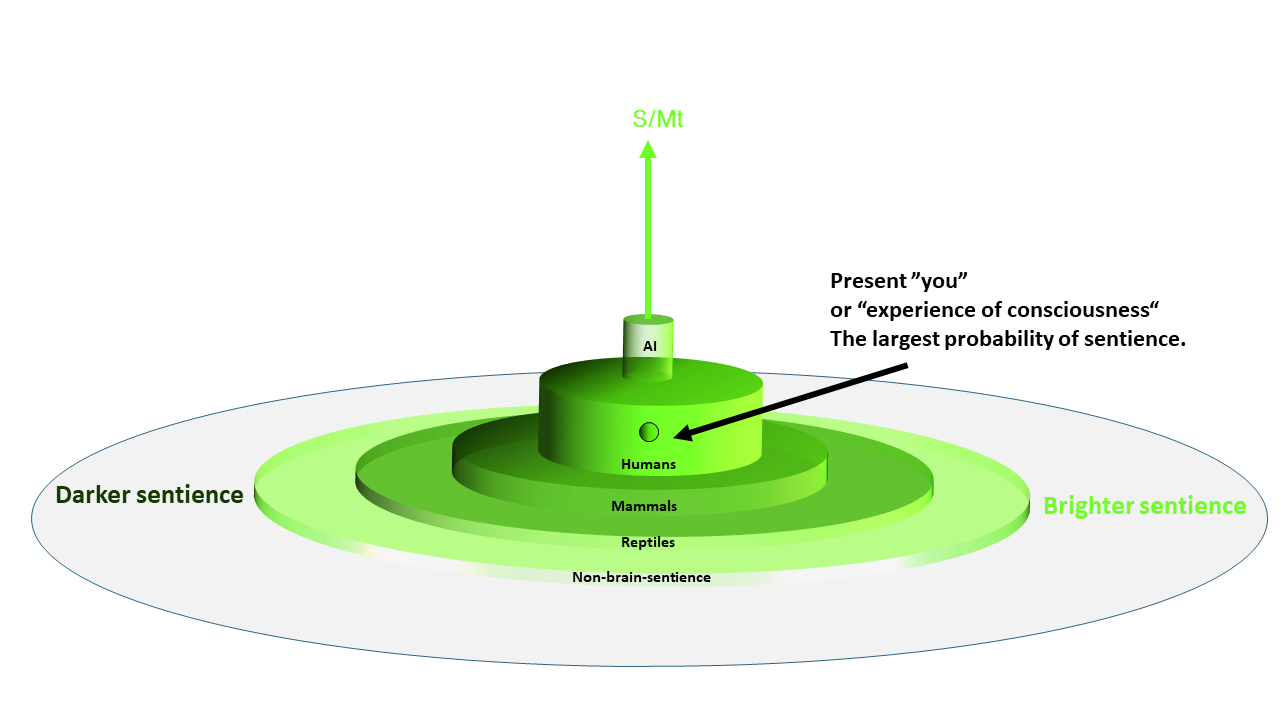
As explained in the introduction, sentience – and particularly bright sentience – is what gives value to anything and everything. Following this logic, altruism must address one of the following four actions. Altruism:
- Grows sentience (widening a cylinder)
- Makes sentience more resilient (ensuring a cylinder against any level of collapse)
- Brighten sentience (brightening any part of a cylinder), or
- Deepens sentience (increasing the depth of a cylinder)
This plasticity is what gives merit to action in general. Consequently, altruism is here scoped to encompass only any action that causes the overall sentience (including one’s own) to grow, strengthen, brighten, and/or deepen. While this logic bears similarities with utilitarianism, the same differences apply here as in EA. No actions are assigned, and the logic is a framework for scientific understanding.
Transsentientism, resilience, and meaning
Genes seem to be the very fabric of life as we know it, and they evolve through a “survival of the fittest” model. This can in other words arguably be referred to as “resilience”. According to our empirical foundation about life (confined to planet Earth), one could argue that the past 65 million years, what has been the fittest has been the most intelligent species. After the extinction of the large dinosaurs with reptile brains, rodents with a limbic system and an emerging neocortex were able to use their higher brain capabilities to adapt to a new world with new rules. Since then, intelligence has largely controlled a species place in the food chain. An opposing argument could be here that e.g. microbial life is more resilient than a species like homo sapiens who is dangerously able to self-destruct with nuclear bombs, designer viruses and the like. However, this paper argues that intelligent life has a greater potential to reach a very high resilience level than less intelligent life since it can find ways to deflect natural disasters and consistently make “backups” of its species on other planets. However resilient the realm of bacteria is, there is so far no evidence in astrovirology that they can consistently proliferate across planets let alone solar systems. So, while humanity is currently less resilient than e.g. bacteria, we at the same time have a higher resilience potential than bacteria.
It seems ironic and peculiar that the very thing that the past 65 million years have made species most resilient (intelligence) is at the same time also the very thing that creates the largest amount of overall sentience, and inherently with it, bright sentience; i.e. the thing that makes living creatures enjoy ever higher levels of beauty around them such as e.g. music, art, and humour. So, as a side effect to being potentially resilient, we also happen to become ever better at being an audience to ourselves – the universe – thus, expanding and brightening the holes in the cosmic black ball. In this way, sentience and intelligence seems the past 65 million years to have found a way to increase its likelihood of continuous growth and resilience. Sentience and intelligence, exemplified by abes, humans, post-humans, and future sentient AI agents, seems to be both the purpose and the roadmap of evolution and meaning.
A part of sentience is being able to sense the world around us. Figure 6 illustrates the importance of removing discrimination of altruism. If the green field represents the spectrum of feelings and sensations that could be accessible to humans, a bigger field of feelings and senses is probably accessible to trans-humans. An even larger field represents senses accessible to post-humans. This space is lastly also not necessarily equal to the space of all possible modes of sentience. The same can be drawn for any other species – organic or artificial.

Looking at sentience isolated, it seems to have a trajectory. DNAs evolved from sentience as “thinking” from a reptilian brain to sentience as “thinking” as a reptilian brain with an outer layer of a limbic system. Then – as a layer on top of that one – a neocortex. Since intelligence is now the “fittest” or “most resilient”, it seems that this levelling-up of sentience is the very spearhead of evolution itself. As the neural network of the brain seems to have a hierarchical structure with no apparent theoretical ceiling, there is no reason to think that the evolution of intelligence should stop at the current human level. Even if there is a physical limit as to how much brain matter can fit in the confinements of a human skull (Bostrom, 2014). As an evolutionary attempt, the brain surface has effectively already curled up to accommodate for a larger surface inside the skull. From an evolutionary point of view for sentience, a natural next step would thus be to expand the brain with an additional layer of hierarchy by growing further in size. Since the skull needs to pass through the birth canals of women, the evolution has so far reached a barrier of growth which might take thousands of years of evolution to overcome. This could e.g. by larger birth canals of women or a more compact brain structure. During those thousands of years, a natural extinction event could prevent this evolution to continue and thus “reset” sentience to a lower and less resilient level – which again seems to be the opposite of what DNA wants with its desire to be resilient.
The outer space seems very hostile to life. Taking aside radiation, cold, vacuum, and toxicity, the phenomenon of entropy dictates that everything is becoming more and more uniform, thus consistently destroying heterogeneity in the Universe. But there are small upstream eddies of biology that create order in this rapid torrent of entropy. And natural disasters put a timer on our evolution. It could be next Tuesday, or it could be a million years from now.

So, with the precarity of life, what should be sought to be preserved above all else. What should we strive for in the current seemingly explosive pace of innovation with designer babies, deep neural networks, and brain-machine interfaces? And what should we strive for in future scenarios of political instability involving animals, humans, post-humans, AI agents, and/or aliens? What really matters above all else? This is an unavoidable question in EA, and one that transsentientism in this paper offers a suggestion for an answer to.
Transsentientism is in this paper defined as the active, non-discriminatory, and deprovincialized contribution to growth, strengthening, brightening and deepening of sentience. It builds upon the terms, transhumanism and sentientism with regards to altruism. In the 13th century in Italy, humanism was born. It attached prime importance to humans rather than divine or supernatural matters. Transhumanism was born in the 1960’ies as the belief or theory that the human race can evolve beyond its current physical and mental limitations, especially by means of science and technology. Sentientism is an ethical philosophy born in the 1980’ies that uses evidence and reason, and grants degrees of moral consideration to all sentient beings. Sentientism extends humanism by showing compassion for non-human animals as well as potential artificial and even alien intelligences. In common with humanism, sentientism rejects supernatural beliefs in favour of critical, evidence-based thinking.
While humanism refers to the devotion to the contribution of well-being of humans, sentientism refers to the devotion to contribution to well-being of all animals with the argument that their sentience justifies the validity of contributing to their well-being. Transhumanism builds upon humanism by asking: Why stop at “well-being“? If homo sapiens is only one step of a continuous evolution, then why not contribute to the advancement of humanity beyond what is currently possible to enjoy. Transsentientism can equally be presented with the question “Why transcend well-being for only humans?”.
The transsentientist conviction that the value of anything is its ability to expand and/or brighten sentience is derived from the overall conviction that a universe that can observe itself is more interesting that a universe that cannot. In this line of thought, similar to utilitarianism, if a waterfall on a planet in another solar system is never going to be observed by any sentient being, then the value of that waterfall throughout all time is set to 0. Similarly, the value of any invention is its ability to expand and/or brighten sentience. Discrimination between species or regions is from this perspective obsolete. I.e. a human, a wolf, and an AI are valued equally if they have the same amount and brightness of sentience.
This conviction encourages and celebrates a “deprovinsialisation” of altruism. The term deprovinsialisation is borrowed from Sagan (1994). While humanism (e.g. poverty alleviation) is altruistic, it is a more provincial form of altruism than the larger transhumanism which aims to not only alleviate poverty but also increase sentience beyond humanism. Transhumanism is again more provincial than trans-sentience which not only aims to alleviate poverty and transcend humanity, but also aims to transcend all sentient beings by not being discriminative towards any two sentient beings (see Figure 8 below).

Sentience and the technology tree
Technological advances have so far been some of the most effective altruistic drivers. Fire, the wheel, the printing press, and antibiotics are examples of technologies that have advanced the wellbeing of civilization and thus expanded sentience. Figure 9 illustrates the technology and its continuum of maturation. The illustration shows the rapid growth of eight sectors in the global economy: Additive manufacturing (or 3D-printing), nanotechnology & robotics, artificial intelligence (AI), genetic engineering, space exploration, energy generation and storage, and augmented, virtual, and mixed reality. These sectors are expected by many to grow rapidly the coming decades and centuries, but since future telling is impossible, Figure 9 includes no timeline. Moreover, this number of exponential sectors will vary with time. Maturity is illustrated as the continuum, which in theory can move both up and down with the passing of time. With the maturation comes not only higher technological capabilities paving the way for inventions but also technological cross-capabilities in which two given sectors benefit from each other. This convergence creates strong synergetic outcomes. As examples of convergence are 1) the convergence of genetic engineering, additive manufacturing and the internet leads to the invention of lab-grown organs and meats, or 2) the convergence of nanotechnology & robotics, genetic engineering and the internet leads to the invention of the CRISPR-Cas9 technology.
In this dilation of maturity, the total green surface at any given point in technological maturity is the real estate of fertile soil for breakthrough inventions.
Here, any future technological invention, similar to the invention of the wheel, can help advance civilization further and with it, sentience; e.g. the invention of a cure for cancer leading to longer lives and thus more sentience, or the invention of rockets with 3D-printing capabilities to print a colony base on Mars, leading to a larger surface area upon which to grow many species which would expand the total amount of sentience in the solar system.
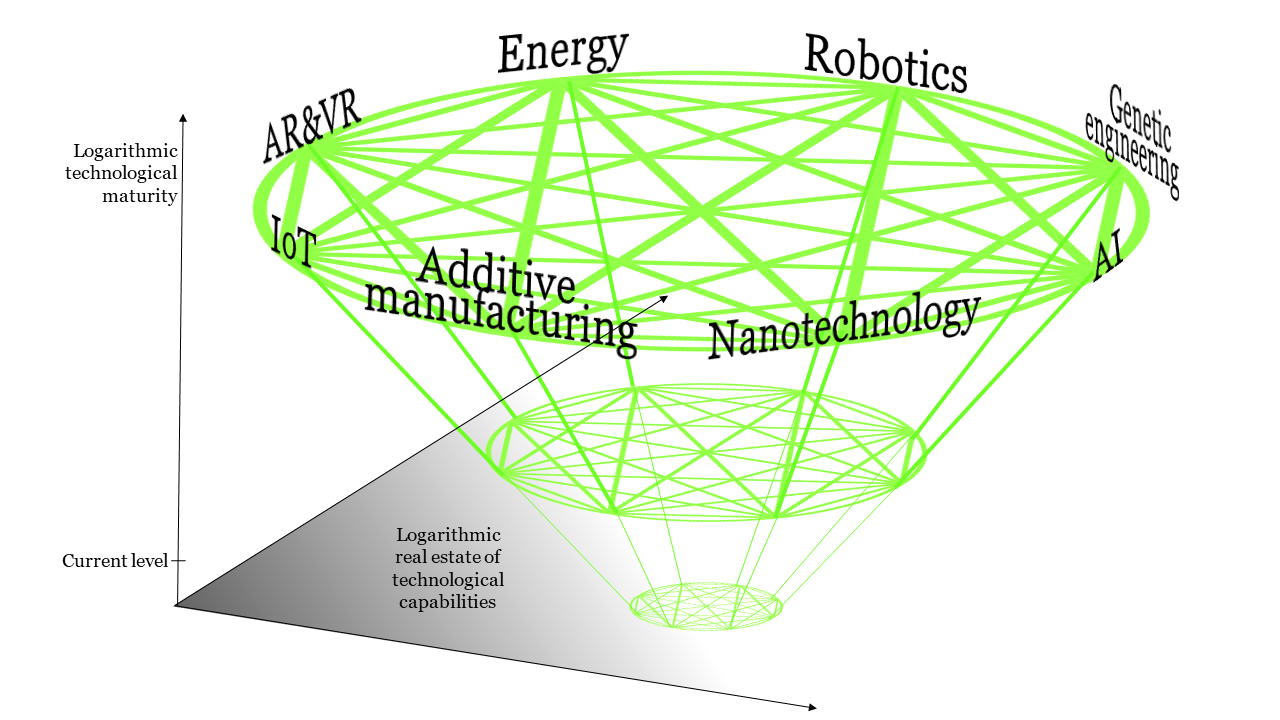
Each one of these technologies are in exponential growth and thus the ring dilates and the total surface (length and width) of the outer ring expands. With it, each conversion between any two branches is also in exponential growth. So, also the acceleration of green surface area of the technology real estate is accelerating. Hence, the logarithmic scales on the illustration.
This rapid expansion the fertile soil of convergence between technologies allow for a consistent acceleration of innovation and thus a consistent acceleration in the ability to perform altruism. Remembering the sentience tree in Figure 4, in order for the tree to grow, it needs water from the ground. The water of the sentience tree is in this analogy technology. With the maturation and dilation of technological capabilities come a faster growth of sentience.
This can be analagous to the level of water in a plant pot. The higher the water level, the more fertile the soil for the plant to grow.
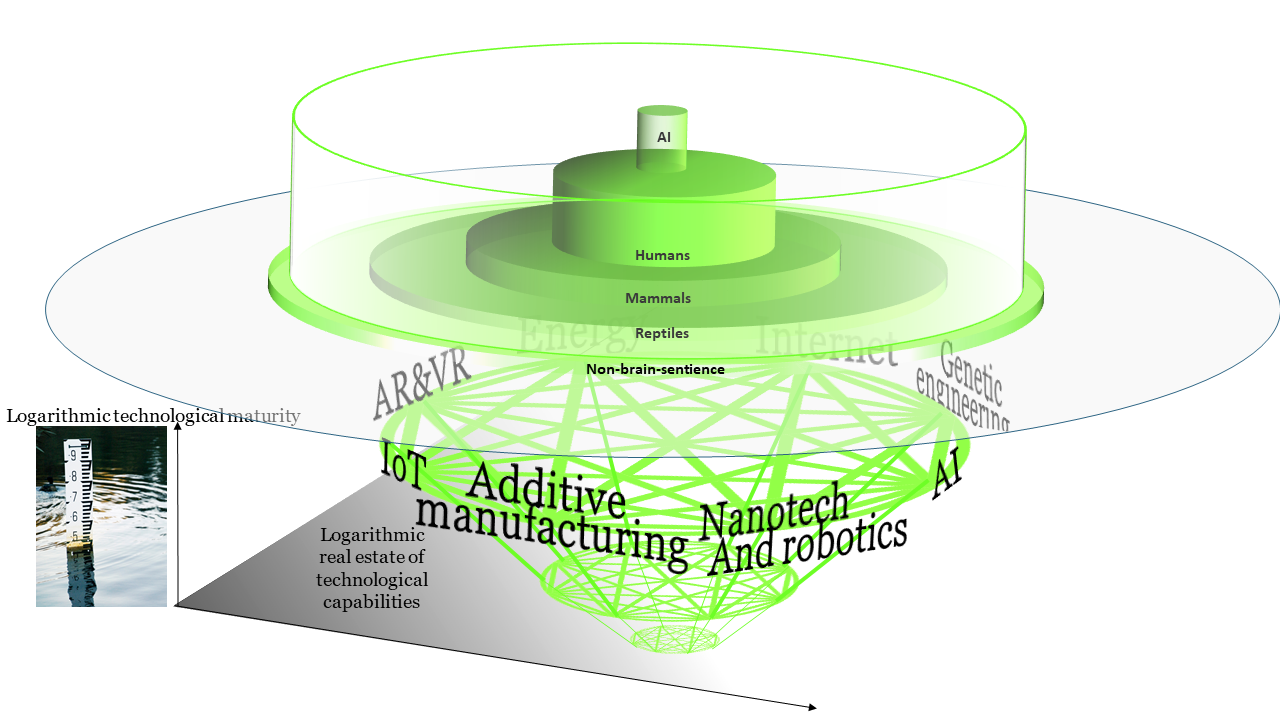
The sentience equation
This paper suggests an equation (see Equation 1) for how to focus our development so as to optimally create bright sentience by expanding, strengthening, brightening, and deepening the precarious “eddie of life” (as described in Figure 7) as fast as possible. Similar to utilitarianism, if we assign this equation to our lives, then that means that we assign validity scores and thus preservation validity to each one and each thing around us.
The sentience equation has no discrimination between species, geography, or time, including hypothetical ethical future complications with any emergence of AI-agents or even aliens in that it does not favour one sentient being over another with the same total validity of preservation score and in that it incorporated probability and resilience as factors for validity of preservation.
1 “Sention” is here defined as the bright sentience of the equivalent of one human being. For the sake of simplicity, this part is set to be half of all sentience of a person.
Phrased more specifically, 1 Sention is half the amount of the phenomenon of perception or feeling at the magnitude of the equivalent of an average human being in present time with its internal perceptions and feelings that partly build upon the external both technical and non-technical stimuli.
Hence, we can collect that for a current human population of around 8 billion, the current human bright sentience is the equivalent of 4 billion Sentions.
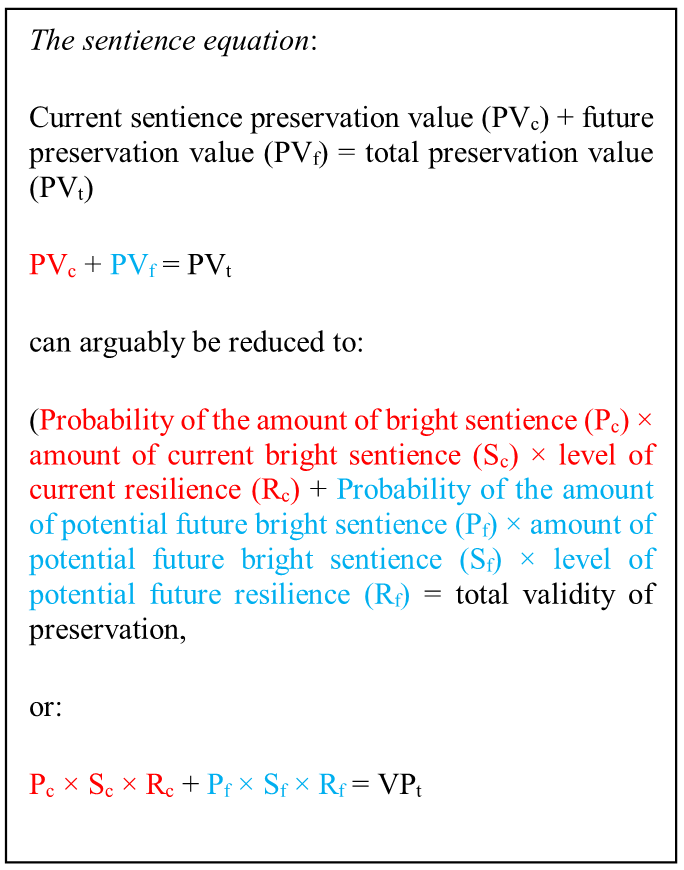
While oversimplified, this metric system is useful in transsentientism and EA because it offers a system of reference.
Our moral obligation to preserve
If humanity goes extinct, we have no certainty that another equally or more intelligent species could take over – let alone exist in the Universe. Not even that another species out there that is less intelligent in time could take over after an extinction event of humanity. Therefore, through the precautionary principle, humanity has an intrinsic responsibility to preserve, evolve, and ideally proliferate their level of sentience that for all we know we could be the highest level of sentience ever created and that will ever be created in this Universe of Multiverse. If beings more sentient than humans emerge with a higher overall preservation value (incorporating the projected level of future sentience), then according to the sentience equation, striving to ensure the prosperity of such beings is more utilitarian or effectively altruistic than striving to ensure the prosperity of humans. Maybe, there is a plethora of intelligent life out there that has a much higher sentience than ours, a much higher potential sentience, and a much higher resilience than us. But since we don’t know that for certain, the precautionary principle suggests that if we cherish sentience, then we have a responsibility to proliferate Earth’s bright sentience until we become certain that there is a better way of preserving sentience.
Intelligence itself might soon have found a way to speed up its own development by adding a non-biological tertiary layer to the skull which can wirelessly pass the skull-barrier and allow for rapid growth. This is more popularly referred to as brain-machine interfaces, or BMIs. The rapid speeding up is partly because such tertiary layer is not confined to any skull, warehouse, or region, and can therefore offer very high computing power for the brain. The intelligence could grow unprecedentedly and create more sustainable life while at the same time create greater sentience with ever increasing senses and perceptions. A better audience for the Universe by the Universe, and thus a brighter cosmic ball of sentience and, in turn, more meaning and value. While evolution could expand the skull through thousands of years, this new invention could do the same thing in perhaps hundreds of years or – if things really speed up – in decades. Such non-biological layer is being made possible by rapid self-enforcing innovation generated by the convergence of nanotechnology, robotics, mixed reality, IoT, additive manufacturing, biotechnology, and processing power.
There is a risk though. Humanity seem to be at a developmental stage now with a relatively and temporarily low resilience and thus high risk of extinction, mainly by self-destruction. Our current intelligence level seems to be a hurricane of dangers since we can invent tools powerful enough to do large scale harm. There was a lower technological maturity level before this point where humanity was in a lower risk than now of self-destructing because we simply were not technologically capable of doing it. Similarly, there is perhaps a lower risk of self-destruction once we reach a higher technological maturity level than now because 1) “backup” tools are in a not too much higher technological maturity level such as expanding to Mars, and 2) a higher emotional intelligence come with a higher technological maturity level, which reduces ignorance.
Here, it is important to appreciate the difference between a global catastrophic risk and an existential risk according to Bostrom 2012, and MacAskill (2018). There is a very big and important difference. Whereas global catastrophic risks affect all living creatures on the planet, an existential risk affects the same plus all future generations that potentially were to live out their lives. In a scenario where humanity was to colonize the whole Milky way galaxy and thus increase the total amount of bright sentience a billionfold, then the difference between a current global and existential risk is per definition at a cosmic scale. Currently there are 7.5 billion people on the planet. In total, 107 billion people are estimated to have ever lived. Therefore, for every living person today, there are roughly 14 dead people. If humanity were to live for another 1000 years, there could for every living person today be hundreds or millions of people not yet born. Therefore, an extinction event is cosmically larger than a global catastrophic event. So, if it will take only another hundred years before a tertiary layer is installed in a considerable number of individuals, e.g. human or abe-individuals, then that means a hundred years of a quite high risk of extinction. According to Bostrom (2012) we could imagine that humanity is currently navigating in a space of three dimensions; namely technology, insight, and coordination, see Figure 10.

Figure 10 The existential risks as our technological level matures. Source: Bostrom (2012).
While we do need to get to a high level of technology in order to reach a high level of both sustainability and sentience, we can imagine that there are potentially existential risks at technological level. These potentially risks can be mitigated by adjusting the level of insight and coordination in the global society.
Building on Figure 10, we could further imagine that some areas within this three-dimensional space could boost us even farther outwards towards our goal of becoming more sustainable and brightly sentient; e.g. by installing BMIs. Building upon Bostrom’s concept of existential risk, the axes could be modified. Insights, technological advancements, and coordination are all arguably essentially communication within and between sentient agents. Communication can be described as the number of senders, receivers, pathways, and information travel speed. Or in the case of a brain or a network of brains, communication is the number of neurons, the number of synapses (internal or external) per neuron, and signal speed. Thus, Figure 10 can be translated into Figure 11. Here, white arrows have also been added to represent any hypothetical local rapid advancement lanes such as e.g. the invention of a sort of mixed reality (or BMIs) that boosts emotional and abstract intelligence in human

Figure 11: Sentience evolution. The Earth is the rocket. Source: Own production.
The extend of sentience on Earth is uncertain. Some relatively high probability can be assigned to your neighbour being sentient. A lower probability can be assigned to your mammal pet dog, and yet lower to the reptilian gecko on your porch. Further, the sentience of fungi, insects, bacteria, the Earth, or Cosmos can be assigned a perhaps somewhat lower probability than the gecko. There is always, however, the probability that your experience of sentience derives from a simulation in which you are the only sentient being (Bostrom, 2003). In this way, sentience probability is all around us.
Moreover, the resilience of a given individual or species also affects the likelihood of future sentience. A species with greater resilience has through natural selection a greater probability of proliferation and thus has a greater number of future individuals.
A 3-dimensional space can then be imagined with the preservability as the volume under a given position, see Figure 12. If an individual or a group of individuals are at position A and are moving to position B, then the preservability of those individuals is the volume of the shell A + the volume of shell B.

Figure 12 The volume of sentience. Source: Own production.
3. Methodology
The assignation of the correct numerical values helps to ensure a balanced applicability of the sentience equation. As mentioned in the introduction, this paper focuses more on the more large-scale EA than the narrower rule utilitarianism. The calculations in the methodology are all designed to support map out magnitude and neglectedness of very large dimensions with the objective to locate any opportune areas of research and work that could be relatively worthwhile to invest in as a political entity or large investor. The calculations are therefore designed to be used exclusively for this large-scale.
Sentience parameters
Two examples of the applicability of Equation 1 is illustrated below. Equation 2 illustrates the total preservation value of humanity calculated with the sentience equation.
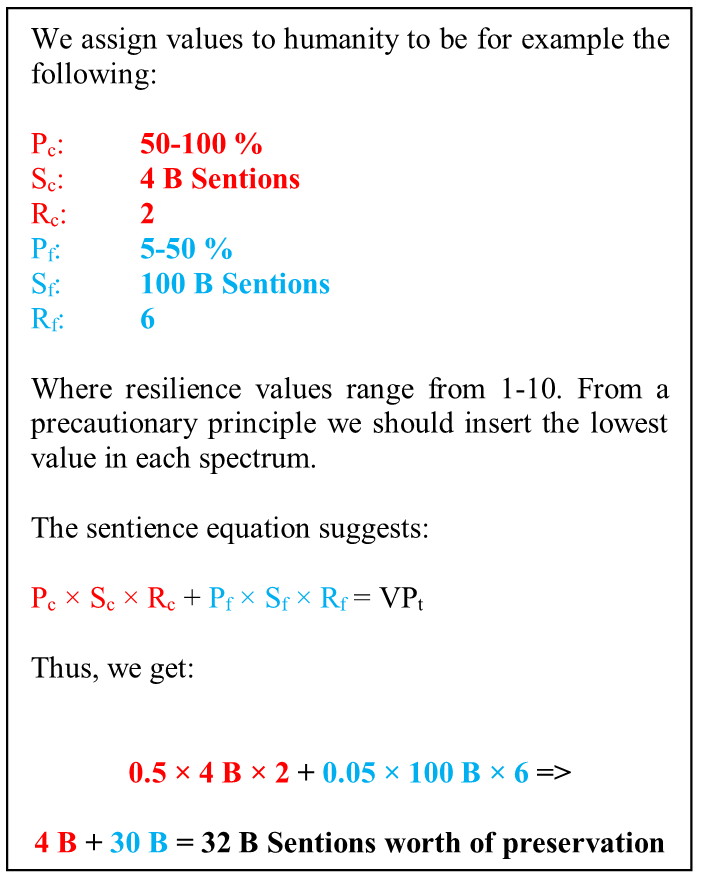

The potential Sention gain varies between these paths. Some paths have a greater altruistic impact if reached than others. E.g. the complete colonisation of all planets and moons in our solar system could arguably give a greater Sention increase than any medicinal brightening could potentially offer. Therefore, an altruistic effect could be assigned to each of the 15 paths should any of them significantly be advanced.
The above methodology underscores the importance of a proper assignation of both current and future probability and resilience factors, as well as the assignation of the effect of the 15 or more paths.
Since EA is based on critical thinking and evidence-based theories, the assignation of all the above factors should be crowdsourced from as wide and as competent a panel of experts in relevant scientific fields as possible. For this reason, this paper proposes a survey of 50 experts in AI, philosophy, technological convergence, and business development that requests the filling out of the templates in Table 1 and 2.
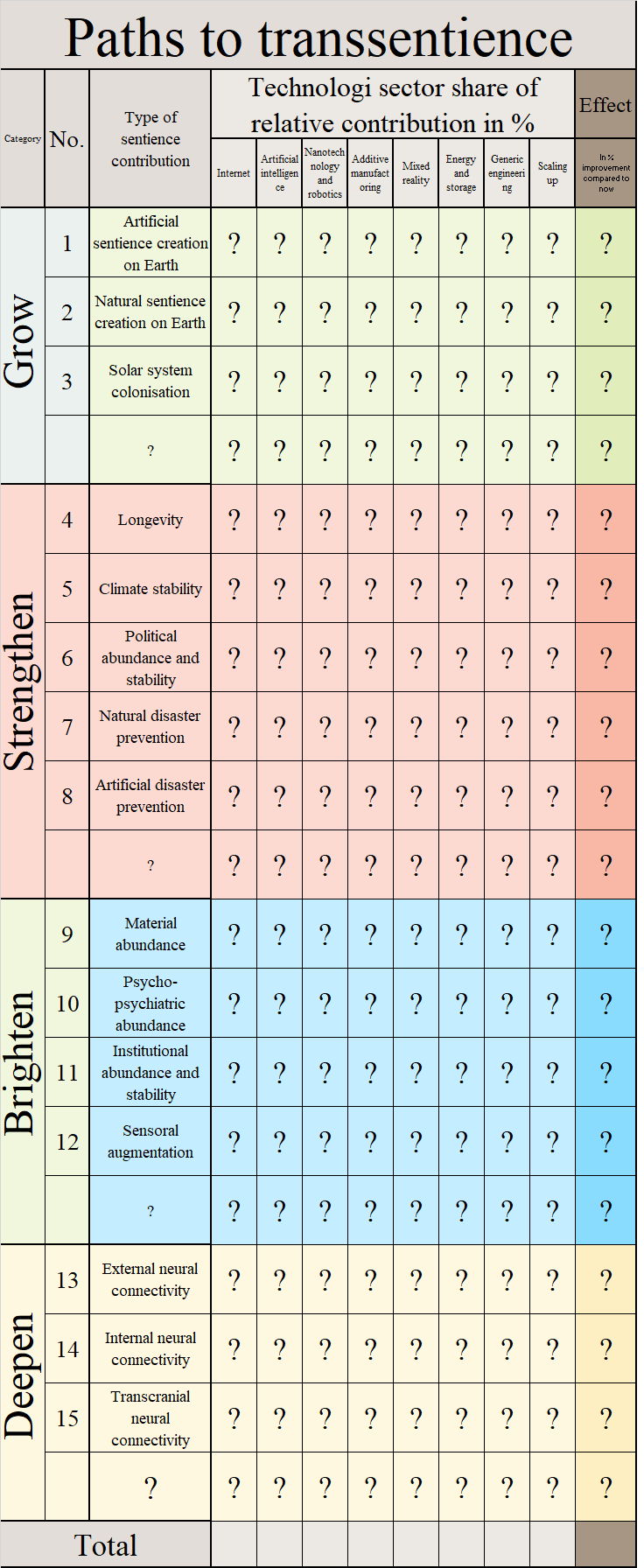
Such crowdsourcing is here proposed to happen in the fall of 2020 if possible. A copy of this paper including a one-page summary and a five-page summary, will be attached to a spreadsheet in Excel with the question marks highlighted.
Every expert would then be invited for a semi-structured interview on Zoom with the author of this paper in which the methodology will be discussed and to the extent possible the cells will be sought to be filled out.
After the filling out, the results can be computed and illustrated.
The outcome will be a weighted distribution of the eight ETSs, corresponding to the crowdsourced estimate on how effective the altruistic effort is of contributing to maturing a given ETS. There are globally research teams working on maturing all the ETSs, both in universities and in R&D-departments of private organisations. If the effort of progress could be quantified, then an award system could be setup that could celebrate the most contributing team to bright sentience. With universities, the beginning of one such quantification could be argued to exist in the Shanghai Ranking system. Here, universities worldwide are ranked based on the papers they publish amongst other factors. This ranking exists on an approximate ETS level, and the most contributing universities on ETS-level is listed in Once filled out, the weight distribution can be calculated and compared to the university ranking in Table 3 below.
Table 3 below. Here, the top five universities are included to show the candidates of an award according to the crowdsourced weight distribution (CWD).
Ranking R&D-departments in private organisations are harder because their results are not quantified to the same extent as universities.
Finally, the CWD can be compared with the amount of peer reviewers in each sector to compare the two weight distributions, examine the correlation, and advice for any significant possible deviation from the CWD within the eight ETSs.

TCP combined weight distribution results
The outcome of the CWDs is ideally two filled out tables with a high participation number. In Table 5 and Table 6, indicative imaginary numerical valued have been assigned to each cell for the sake of an example.
serves exclusively to aid in filling out the effect of all of the 15 or more paths to more bright sentience. In this way, only Table 6 would directly be used as input for the analysis.


In order to advance significantly on these paths, a greater technological maturity is required than what is currently reached and distributed. The technological maturity illustrated in Figure 9 can here be used to gain insights into what technologies to reasonably expect to be maturing sooner or later if any rate of progress prevails. This illuminates what areas are more solvable (according to the EA framework). On any of the 15 paths, a different subset of technological maturations is required to advance. An estimate of the respective subsets of technology maturations for each of the 15 paths is illustrated in Figure 14 below. The data of this figure is in annex I.
The height of any of the columns represent the overall effect of reaching the destination of a path (in % Sention increase).
From this illustration, not all technologies are equally effective in terms of altruism. The internet, AI, nanotechnology and robotics, and genetic engineering are e.g. in this subjective example relatively much more effective than other ETSs. This is better illustrated in Figure 15.


Here, four technologies can be accredited most of the honour of having contributed to reaching the 15 paths.
As a validation of transsentientism in comparison with humanism and transhumanism, only a subset of the 15 paths can be subscribed to the transhumanist visions. Yet a smaller subset can be subscribed to the humanism visions. This is visualised in Figure 16.
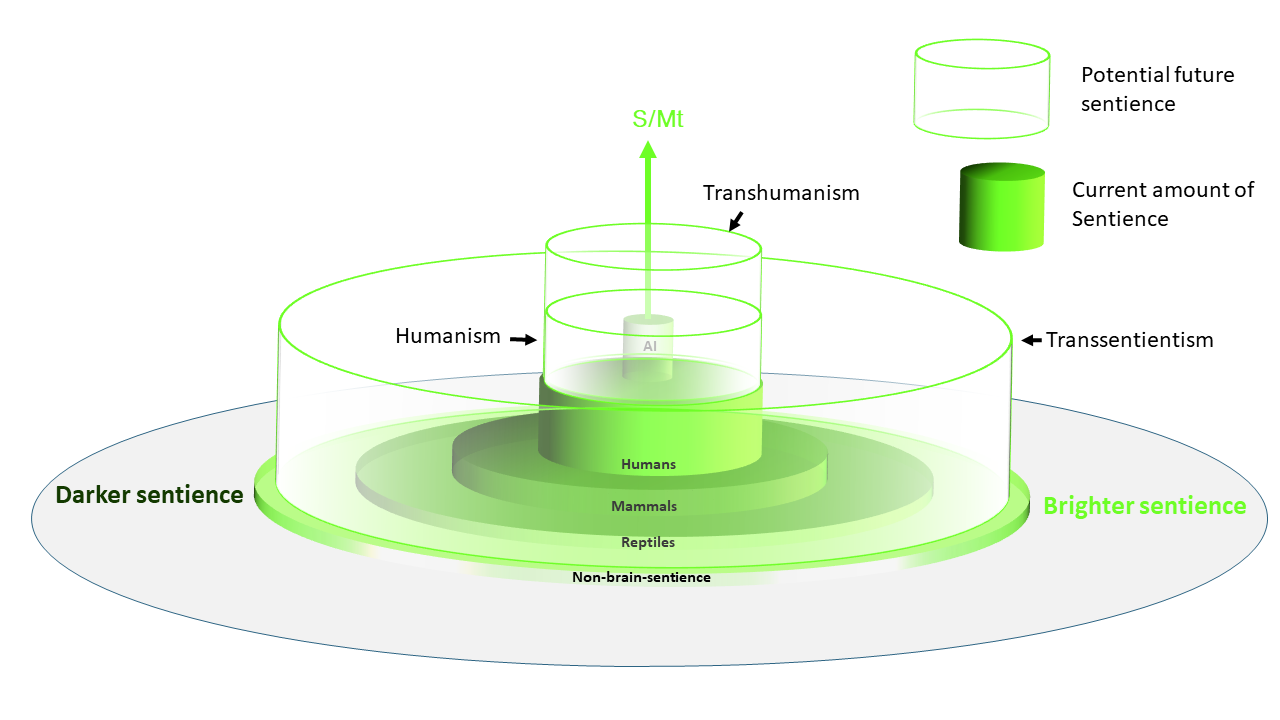
Following the logic of Figure 16, the visions of sentience growth within humanism and transhumanism are reduced as illustrated in the Figure 17 and Figure 18. The crucial point here is the assigned cost effectiveness of any small maturation of any of the ETSs because this indicates the neglectedness of a given problem. As stated in the introduction, the neglectedness is one of the three principles in EA methodology.


Because of the humanist and transhumanist views, different overall weight is assigned to each of the ETSs, which leads to different conclusions on the magnitude and neglectedness of a given ETS – and thus, problem.
This difference is illustrated in Figure 19 and Figure 20 below.


Here, the distortion in the global aspiration and decision making becomes more evident because this would be the compass of EA recommendations to altruists and world leaders. This distortion can therefore have dire consequences for the teeming of abundance bright sentience in the future. This article aims to start a discussion that could lead to an adjustment of a part of this distortion and in that way contribute to a brighter future for us all.
5. Analysis
The empirical data above could serve as a foundation to produce a ranking of contributions to sentience through an “EA of ETS” metric system which would estimate the relative magnitude of a given problem. It could also serve as a comparison to the current constellation of scientific peer reviewers which represent the prioritization of research focus, to give an estimate of the relative neglectedness of a given problem. Both is described respectively below.
Time
Magnitude ranking
By assigning the CWD to the Shanghai ranking score from Table 7, universities contribute to bright sentience in the following relative magnitude:

Figure 21 The top universities’ contribution to sentience. Empirical data is imaginary. Source: Own production.
In this imaginary example, MIT take the first place as a top contributor to overall growth of bright sentience across all eight ETSs. A complete ranking from the imaginary empirical data is showed below.
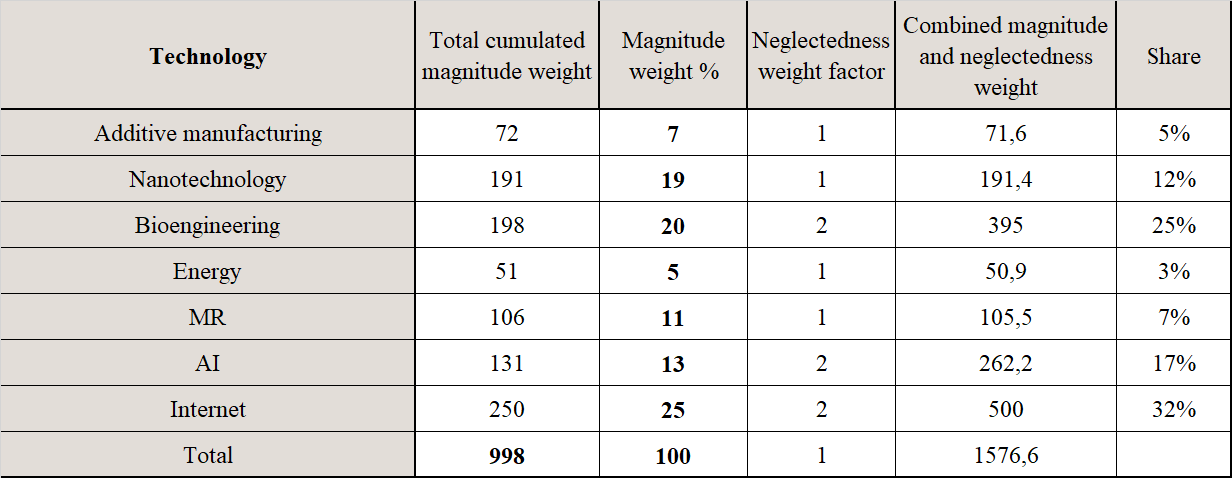

Neglectedness ranking
The constellation of the peer reviewers worldwide based on scientific field is illustrated in Figure 22 below. Here, the share of each of the ETSs is included as a point of comparison. Since the exact amount of peer reviewers per ETS is not mentioned, the comparison for this paper will have to be only a visual comparison. For the empirical data collection via crowdsourcing, the actual numbers will be requested from Publons.

Figure 22 A comparison of the global disciplinarian constellation of peer reviewers and their overlap with the shortest roadmap to sentience. Source: Publons (2018), a website that helps academics to track their reviews and other contributions to scientific journals. The authors used data from the survey, conducted from May to July 2018, as well as data from Publons, Web of Science Core Collection and Scholar One Manuscripts databases
But for now, the visual overlay analysis of the ETSs shows that only around 1/3 of the research revolves around bright sentience. This implies a certain neglectedness for some of more of the ETSs, and according to the figure, the largest neglectedness lies within the AI, Internet, and genetic engineering research. Thus, these three ETSs can be multiplied with 2 to receive extra value corresponding to their lesser size compared to the other ETSs. This new weight can then be reapplied to the calculations already made, which gives a combined magnitude and neglectedness EA ETS score as shown in Table 9 below.
In other words, this ranking would show the relative magnitude of the problems that a given university is working on from a transsentientist point of view. This ranking should of course be merged with the neglectedness ranking to show a more applicable ranking for the EA field.
The calculation itself is a weighing of contribution to what is needed to advance in the 15 sentience paths shown in Figure 14. Such ranking could be updated every year to give a running score.
From Table 8, a ranking of the highest performance contributors to bright sentience in terms of research appears. The calculations in this example are not showing the real ranking for five reasons. First, the numerical values are imaginary; second, the Shanghai Ranking is not a perfect depiction of the contributions to the research in each ETS; third, there can be more research fields than the ETSs that contribute significantly to bright sentience creation; fourth, only the top five universities in each ETS has been included in this calculation; and fifth, the calculations in this paper have not been peer reviewed.
Nevertheless, this ranking could serve as a foundation for a scientific discussion about EA and perhaps push the promising field of EA towards including more sectors in its empirical data collection and critical thinking.
By including more sectors, a more generic and cross-disciplinary gamification of EA could help bring forth a larger investment like what has been seen in e.g. the X-prize foundation, where large awards are promised to advance a specific scientific field considerably in a certain direction. This could in turn give the scientific community a greater influence in the stewardship of the future of life, which this community has a certain responsibility of nudging in the right direction due to their ability to use high quality evidence and careful reasoning.
Money and political engagement
The TCPM can also be applied to the private and political sector, albeit with less precision than in the research sector since there is no equally complete ranking sorted by ETS-level in across the global private sector as in the case with the Shanghai Ranking.
Instead, the ETS focus can be reapplied into the 15 sectors which lead to a theoretical weight distribution. This weight distribution is illustrated in Figure 23 where it is compared with the current predominant focus areas illustrated in Figure 13.

Here, a stark contrast between the two focus sets is illustrated. While the current predominant focus areas revolve around stability, prevention, longevity, and abundance, the TCPM data instead revolves around artificial sentience creation, solar system colonisation, and external as well as transcranial connectivity.
Therefore, TCPM in this imaginary example diverges quite considerably from the current discourse. As the more accurate data is replaced with this imaginary data, this comparison will almost certainly look different. Therefore, a closer analysis of these differences will not be produced here.
The comparison can also be made for CWD of ETSs. The results for both the TCP CWD and the current CWD are illustrated in Figure 24. Here, the most altruistic effect would come from increasing focus on the Internet and AI. Other smaller benefits would come from increasing focus of mixed reality, energy and storage, and genetic engineering.

6. Conclusion
The transsentientist critical path methodology has in this paper with indicatory imaginary data proved capable of producing a ranking of both research areas and the private sector in terms of contributing to growth of bright sentience.
Whether this tool has any unique abilities compared to any of the existing tools in the EA toolbox is beyond the scope of this article. The purpose of this article is rather to demonstrate the applicability of this tool and to compare its results with the current prevalent focus areas to find out to what extend there was a match. Since the paper until now only has analysed imaginary data, nothing can be concluded. However, to show a preview of a conclusion, the following two conclusions can be drawn from the imaginary analysis:
- There is a somewhat good correlation between the TPC methodology and the peer review constellation of scientific field, where only three out of the eight ETSs examined were distorted by a factor of about two, and
- There is a very weak correlation between the TCP methodology and the current combined weight distribution of the 15 paths to increase bright sentience.
If 1) real empirical data will be collected for a proper TCP methodology in this article, as stated desired, and if 2) the results show a significant lack of correlation in one or both cases, then a follow-up study could examine the current used techniques and methods used by:
- the forces creating the constellation of peer reviewers,
- the UN community in defining their SDGs.
If in such a study, the TCP methodology proves to have any unique abilities, be validated within the scientific community, and if continuously updated, then such ranking could serve as a dashboard for universities and private organisations that gamifies their work within the scientific field of Effective Altruism.
Regarding research, this ranking could with the help of the Shanghai Ranking of Universities be translated into a ranking of Universities.
If applicable, this tool could also serve as input for a review of the UN SDGs.
7. Epilogue and perspectivization
Utilitarianism and effective altruism argues that we all have an enormous responsibility not only to become more brightly sentient, but also to do it fast before any natural or artificial setback or extinction event, and even before the life of Earth spreads out to other planets with the current level of ignorance and selfishness and for all we know leaves the Universe in eternal sentient darkness with but a few dim lights shining through the ball of sentience. This tool indicates, advocates, and celebrates the fastest paths towards bright sentience.
This celebration could become more prevalent in society through the visual readiness of this tool. With this, awards, prizes, and general celebrations could enhance incentive, optimism, purpose, and collaboration for the broader society about effective altruism.
The advancement of bright sentience is important because a wonderful Universe like ours deserves an audience. Let’s honour this cause, which so many before us have given their lives to advance.
For further reading about the interplay between exponential technology sectors and sentience growth, the following detailed roadmap will be published in a future blog post:
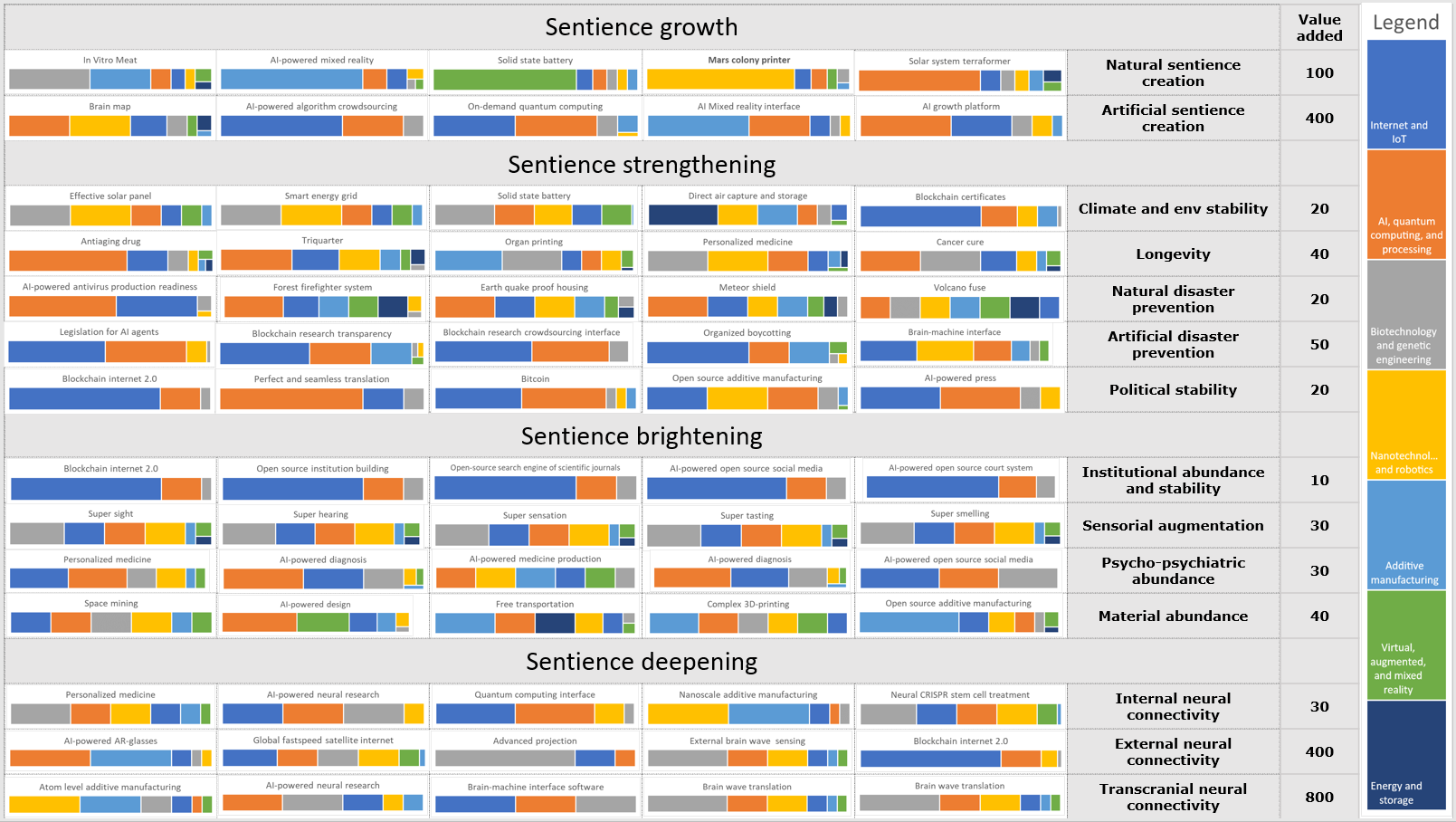
8. List of references
Bostrom, N. (2003): Are you living in a simulation? Philosophical Quarterly, 2003, Vol. 53, No. 211, pp. 243-255.
Bostrom (2005): Transhumanist values. in Ethical Issues for the 21st Century, ed. Frederick Adams (Philosophical Documentation Center Press, 2003); reprinted in Review of Contemporary Philosophy, Vol. 4, May (2005)]
Bostrom, N. (2012): Existential Risk Prevention as a Global Priority. Global Policy, Vol 4 , Issue 1 (2013): 15-31.
Bostrom (2014): Superintelligence. Oxford University Press. Keith Mansfield.
Ford, M. (2018): Architects of Intelligence: The Truth About AI from the People Building It. Packt Publishing
Lexico (2020):
MacAskill, W. (2017): Effective Altruism: Introduction. Essays in Philosophy. Volume 18, Issue 1
MacAskill, W. (2019): The definition of Effective Altruism. From: hTCPs://forum.effectivealtruism.org/ 2020.
Müller V. C. & Bostrom, N. (2016): Future Progress in Artificial Intelligence: A Survey of Expert Opinion. Fundamental Issues of Artificial Intelligence pp 555-572
Publons (2018): Global state of peer review. From publons.com.
Sagan, C. (1994): The lost lecture. Cornell chronicle. From: hTCPs://news.cornell.edu/stories/2018/11/lost-lecture-carl-sagan-released-honor-his-birthday
Tegmark, M. (2017): Life 3.0. Being human in the age of artificial intelligence. Deckle Edg
9. Appendices
Annex I

Figure 25: Calculations creating the combined weighted distribution of the TCP methodology.
Annex II

Figure 26 Total technology share for paths to humanism

Figure 27 Total share of technologies in paths to transhumanis

Thanks Peter. You might find this site interesting re: Sentientism https://sentientism.info/. There's a global community growing up around it. I think of Sentientism as recognising the moral salience of sentience regardless of species or substrate - so entirely consistent with "transsentientism".
I appreciate the work you put into this and I particularly like the visualizations. I assume Mt means million metric tons, but then you say the biomass is 7 Mt. Plant biomass is 550 billion tons carbon, which means about 1 trillion tons dry matter. So what do you mean? Also, you say “4 B + 30 B = 32B” – is this some rounding issue?